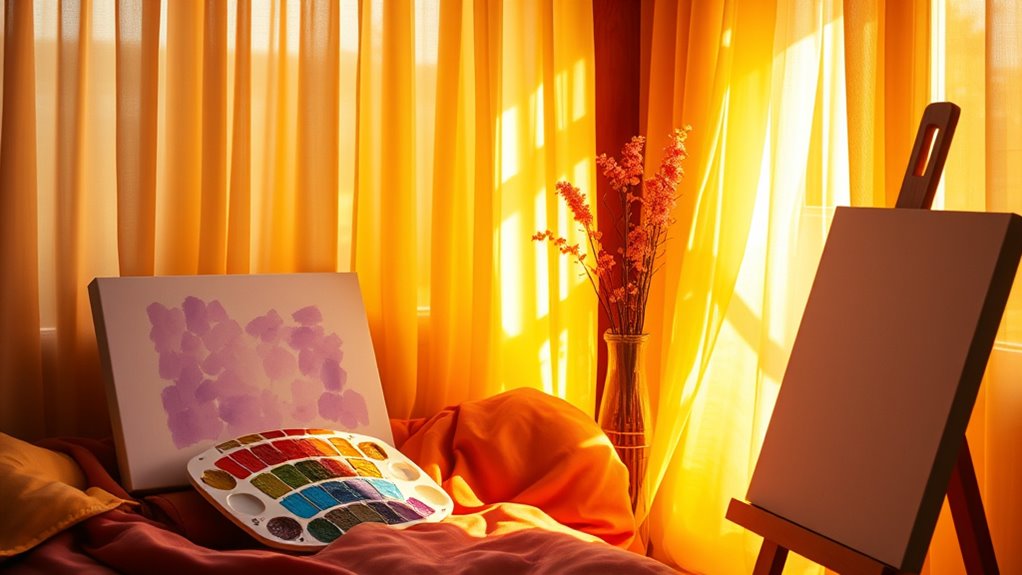Color influences your mood through subconscious associations, cultural meanings, and physical properties like brightness and saturation. Bright hues such as yellow boost happiness and optimism, while cool colors like blue promote calmness and focus. Different cultures may interpret colors uniquely, affecting emotional responses. Scientific studies reveal how specific colors can reduce stress or elevate happiness. By understanding these effects, you can use color strategies to improve your mental well-being—keep exploring to discover how to apply this knowledge effectively.
Key Takeaways
- Color perception triggers subconscious associations that influence emotions and mood, with bright colors boosting happiness and darker shades promoting calmness.
- Different colors symbolize specific emotions and states; for example, blue induces relaxation while red increases alertness.
- Brightness and saturation levels in colors affect energy, relaxation, and emotional intensity, allowing tailored mood regulation.
- Scientific studies using neuroimaging reveal that colors impact neural pathways associated with feelings like calmness or excitement.
- Personalized color therapy leverages individual preferences and cultural meanings to optimize emotional well-being through environmental design.
How Color Perception Influences Emotional Responses

Color perception directly affects your emotional responses, shaping how you feel in different environments. When you see certain colors, your brain automatically associates them with specific feelings, influencing your mood without you realizing it. For example, bright colors like yellow and orange often evoke feelings of happiness and energy, while darker shades such as blue and gray can create calmness or sadness. Your emotional responses to color are deeply rooted in personal experiences and cultural associations, but some effects are universal. As you move through various spaces, your perception of color can boost your mood or evoke subconscious reactions. Understanding how color perception impacts your emotional responses helps you choose environments and decor that support your well-being and emotional balance.
The Psychological Effects of Different Color Families

Different families of colors evoke distinct psychological responses that can influence your mood and behavior. For example, reds and oranges, often linked to energy and warmth, can boost alertness and excitement through their powerful color symbolism. Blues and greens tend to promote calmness and relaxation, with their color symbolism associated with stability and harmony. Yellows are energizing and cheerful, reflecting optimism and happiness in their symbolism. Purple and violet evoke creativity and luxury, influencing your sense of inspiration and sophistication. Recognizing the color symbolism behind these families helps you understand how specific colors can shape your emotional state. By consciously choosing colors aligned with your desired mood, you can harness their psychological effects to create environments that support your well-being.
The Role of Brightness and Saturation in Mood Regulation

While the psychological effects of color families set the foundation for mood, brightness and saturation add nuanced layers to how colors influence your emotional state. Brightness contrast determines how vibrant or subdued a color appears, affecting whether you feel energized or relaxed. High brightness often evokes feelings of alertness and happiness, while lower brightness can promote calmness or introspection. Saturation intensity shapes how pure or muted a color seems; intense saturation tends to stimulate excitement or urgency, whereas muted tones foster serenity or nostalgia. Color psychology plays a significant role in how these elements are perceived and experienced. By adjusting these elements, you can tailor your environment to support your mood—brighter, more saturated colors energize, while softer, less saturated hues soothe. Understanding these subtle variations helps you harness color’s emotional power more intentionally.
Cultural Variations in Color Interpretation

Cultural backgrounds profoundly influence how people interpret colors and their emotional effects. You might associate white with purity and weddings, but in some cultures, it symbolizes mourning or loss. Traditional symbolism varies widely, shaping emotional responses to colors based on cultural context. For example, red signifies luck and celebration in China, yet can evoke danger or warning elsewhere. Understanding color symbolism helps you recognize that meanings are not universal; they are rooted in cultural traditions and histories. These variations impact how colors influence mood and behavior, making it essential to contemplate cultural backgrounds when using color for communication or design. By appreciating these differences, you can better interpret emotional cues and create more effective, culturally sensitive environments. Additionally, awareness of cultural color symbolism can enhance cross-cultural communication and foster greater understanding in diverse settings.
Scientific Studies Linking Color to Happiness and Stress Reduction

Scientific research has demonstrated that certain colors can directly influence your mood, promoting happiness and reducing stress. Studies in color psychology research reveal that specific hues evoke emotional responses based on color symbolism. For example, blue often fosters calmness, while yellow boosts positivity. To illustrate, consider this table:
| Color | Emotional Effect | Common Uses |
|---|---|---|
| Blue | Stress reduction, calm | Bedrooms, hospitals |
| Yellow | Happiness, energy | Living rooms, workspaces |
| Green | Balance, relaxation | Offices, therapy rooms |
| Red | Excitement, alertness | Accents, exercise areas |
These findings confirm that color choices can impact your mood, making understanding color symbolism essential for stress reduction and happiness. Additionally, awareness of color associations can help tailor environments to support emotional well-being.
The Impact of Color in Interior Design and Personal Spaces

The colors you choose for your space can substantially influence your mood and feelings. Bright, warm tones often energize, while cool, muted shades promote calm and relaxation. Understanding how space colors affect emotions helps you create environments that support your well-being. Incorporating color psychology principles can further enhance the positive effects of your interior design choices.
Color Choices Influence Mood
Colors in your environment can profoundly influence your mood and behavior, shaping how you feel and think throughout the day. The choices you make in color can communicate specific emotions and influence your mental state, thanks to the power of color symbolism. For example, blue often symbolizes calmness and stability, helping you feel relaxed, while red can evoke energy and excitement, boosting motivation. Understanding color symbolism allows you to select hues that support your desired mood in personal spaces or work areas. Your color choices aren’t just aesthetic—they’re psychological tools that can enhance your well-being, productivity, or relaxation. In addition, choosing the right colors can be especially effective when considering the psychology of color, which explores how different hues impact human emotions and behaviors. By consciously choosing colors based on their symbolism, you can create environments that positively impact your daily mood and overall mental health.
Space Colors Affect Emotions
When you choose the colors for your living space, you directly influence your emotional well-being and daily experience. Space colors play a vital role in shaping your mood and energy levels. For example, calming hues like blues and greens foster relaxation and reduce stress, creating a peaceful environment. Bright colors such as yellow or orange can boost your mood and inspire creativity. Conversely, dark or dull shades may evoke feelings of heaviness or melancholy. The emotional influence of space colors extends beyond aesthetics; it affects how you feel and function in your surroundings. By selecting colors thoughtfully, you can craft a space that supports your emotional needs, promotes positivity, and enhances your overall quality of life. Understanding personality traits can further help tailor your space to better fit your individual disposition and preferences.
Color Therapy: Using Hues to Enhance Mental Well-being

Color therapy harnesses the power of hues to improve your mental well-being by influencing your mood and emotional state. By understanding color symbolism, you can select specific colors to evoke desired feelings—calmness, energy, or focus. Chromotherapy techniques use targeted light exposure or colored environments to balance your emotions and reduce stress. For example, blue promotes relaxation, while yellow boosts optimism and motivation. These methods are grounded in the idea that colors can directly impact your subconscious, helping you manage anxiety or enhance your mood naturally. Incorporating color therapy into your routine can be simple yet effective, whether through colored lighting, clothing, or decor. Additionally, using specialized planters designed for indoor environments can further support your mental well-being by creating a soothing and inspiring space. By consciously choosing hues aligned with your emotional needs, you harness the therapeutic power of colors to support your mental well-being.
The Connection Between Color and Creativity

The hues surrounding you can markedly influence your creative thinking and problem-solving abilities. Colors evoke specific emotions through color symbolism and chromatic symbolism, shaping your mental state. Bright yellow can stimulate optimism and innovation, while calming blue fosters focus and clarity. Red energizes action but may also increase stress, impacting creativity differently. To understand this, consider the table below:
| Color | Symbolism / Effect | Creative Impact |
|---|---|---|
| Yellow | Optimism, enthusiasm | Sparks ideas, encourages thinking outside the box |
| Blue | Calmness, clarity | Enhances concentration and problem-solving |
| Red | Energy, urgency | Boosts motivation but may cause distraction |
Additionally, understanding how personal growth techniques influence emotional responses can help optimize your environment for creative endeavors.
Practical Tips for Using Color to Improve Mood

To effectively harness the power of color for boosting your mood, start by intentionally incorporating specific hues into your daily environment. Understanding color symbolism can guide your choices—blue promotes calm, yellow energizes, and green fosters balance. Use color symbolism to select wall paints, accessories, or clothing that align with your emotional needs. For example, adding soft blue tones can reduce stress, while vibrant reds may boost motivation. Keep your surroundings harmonious by balancing warm and cool hues based on the mood you want to cultivate. Remember, color symbolism varies across cultures, so choose colors that resonate personally. Small changes, like a colorful throw pillow or artwork, can make a significant difference in influencing your emotional state. Be intentional, and let color support your well-being. Additionally, incorporating colors aligned with energetic alignment can amplify your mood-enhancing efforts.
Future Directions in Color and Emotional Research

Advances in neuroimaging will help you better understand how different colors impact emotions at a neural level. Personalized color therapy is likely to become more tailored to individual needs, enhancing its effectiveness. Additionally, expanding cross-cultural studies will reveal how cultural differences shape emotional responses to color, guiding more inclusive research. Exploring GMC tuning techniques may also offer insights into optimizing emotional well-being through environmental and aesthetic adjustments.
Emerging Neuroimaging Techniques
Emerging neuroimaging techniques are opening new avenues for understanding how color influences mood by providing more detailed insights into brain activity. These neuroimaging advancements allow you to observe real-time responses in the brain’s regions associated with emotion and perception. By examining how different colors activate specific neural pathways, researchers can better understand the connection between color perception and emotional states. Functional MRI (fMRI) and EEG are becoming more sophisticated, revealing subtle patterns of brain activity linked to color stimuli. This progress helps clarify how certain hues evoke feelings like calmness or excitement. As these techniques evolve, you’ll gain a clearer picture of the neural mechanisms behind color’s impact on mood, paving the way for more targeted research and potential applications in therapy and design.
Personalized Color Therapy
As research into the neural effects of color deepens, personalized color therapy is poised to become a powerful tool for emotional regulation. By understanding your unique chromatic preferences and the personal significance of color symbolism, therapy can be tailored to your emotional needs. Your individual reactions to specific hues influence mood and stress levels, making customized color interventions more effective. For example, if you associate blue with calmness, incorporating more blue into your environment may promote relaxation. Personalization ensures that the therapy resonates deeply, tapping into your subconscious associations and preferences. As science uncovers how neural pathways respond to individual color experiences, personalized color therapy will become a precise approach to enhance mental well-being and emotional resilience.
Cross-Cultural Studies Expansion
Understanding how different cultures interpret and respond to colors is essential for advancing emotional research. Cultural symbolism shapes how people perceive and emotionally react to specific hues, highlighting that color symbolism varies widely across societies. Expanding cross-cultural studies allows you to explore these differences more thoroughly, revealing universal patterns and unique cultural associations. This research can clarify how cultural symbolism influences emotional responses, helping to develop more effective, culturally sensitive applications of color in therapy, marketing, and design. By examining diverse cultural contexts, you gain a deeper understanding of how individual and collective color perceptions impact mood. Such expansion will ultimately enrich your knowledge of the complex relationship between color, emotion, and cultural symbolism, paving the way for more nuanced, globally applicable insights.
Frequently Asked Questions
How Does Individual Color Preference Affect Emotional Response?
Your personal taste and cultural influences shape how you emotionally respond to colors. When you favor certain hues, they can evoke positive feelings or comfort, while disliked colors might cause discomfort or indifference. Cultural backgrounds also play a role, as different societies associate specific colors with particular emotions or meanings. Ultimately, your unique preferences influence how colors impact your mood, making the emotional response highly individualized.
Can Color Choices Influence Physiological Health Beyond Mood?
Color choices can influence your physiological health through color therapy, which uses specific colors to promote healing and well-being. Cultural influences often shape how you perceive and respond to colors, affecting their impact on your body. By intentionally selecting certain hues, you might reduce stress, improve sleep, or boost your immune system. While more research is needed, many believe that mindful color choices can have tangible health benefits beyond just mood.
Are There Long-Term Psychological Effects of Exposure to Specific Colors?
Sometimes, subtle influences shape your outlook over time. Long-term exposure to certain colors, through color therapy and color symbolism, can gently guide your psychological landscape. These hues may foster resilience, calmness, or confidence, subtly weaving into your subconscious. Although the effects aren’t immediate, consistent encounters with specific colors might nurture lasting mental patterns, enriching your emotional well-being and offering a quiet, persistent form of self-care.
How Do Lighting Conditions Alter Color Perception and Emotional Impact?
You notice that ambient lighting and color contrast markedly change how you perceive colors and their emotional effects. Brighter lighting can make colors appear more vivid, boosting your energy, while dimmer lighting softens them, creating a calming atmosphere. High contrast enhances color differences, making scenes more striking, whereas low contrast produces a more subdued effect. These lighting conditions influence your mood by altering your perception and emotional response to the colors around you.
What Role Does Age Play in Color Perception and Mood Association?
Ever wonder how age influences your perception of color and mood? As you age, age-related perceptual changes can alter how you see colors, making some hues appear different or less vivid. You might also notice shifts in your emotional responses, influenced by generational color trends that shape preferences over time. These factors combine to impact how you interpret colors, affecting your mood and emotional well-being throughout your life.
Conclusion
By understanding how colors influence your emotions, you can intentionally create environments that boost your mood. For example, painting your workspace with calming blue hues might reduce stress and increase focus. As research shows, simple changes like adding vibrant reds or soft pastels can lift your spirits or promote relaxation. So, start experimenting with colors around you—small shifts could substantially improve your mental well-being and help you feel more balanced every day.









